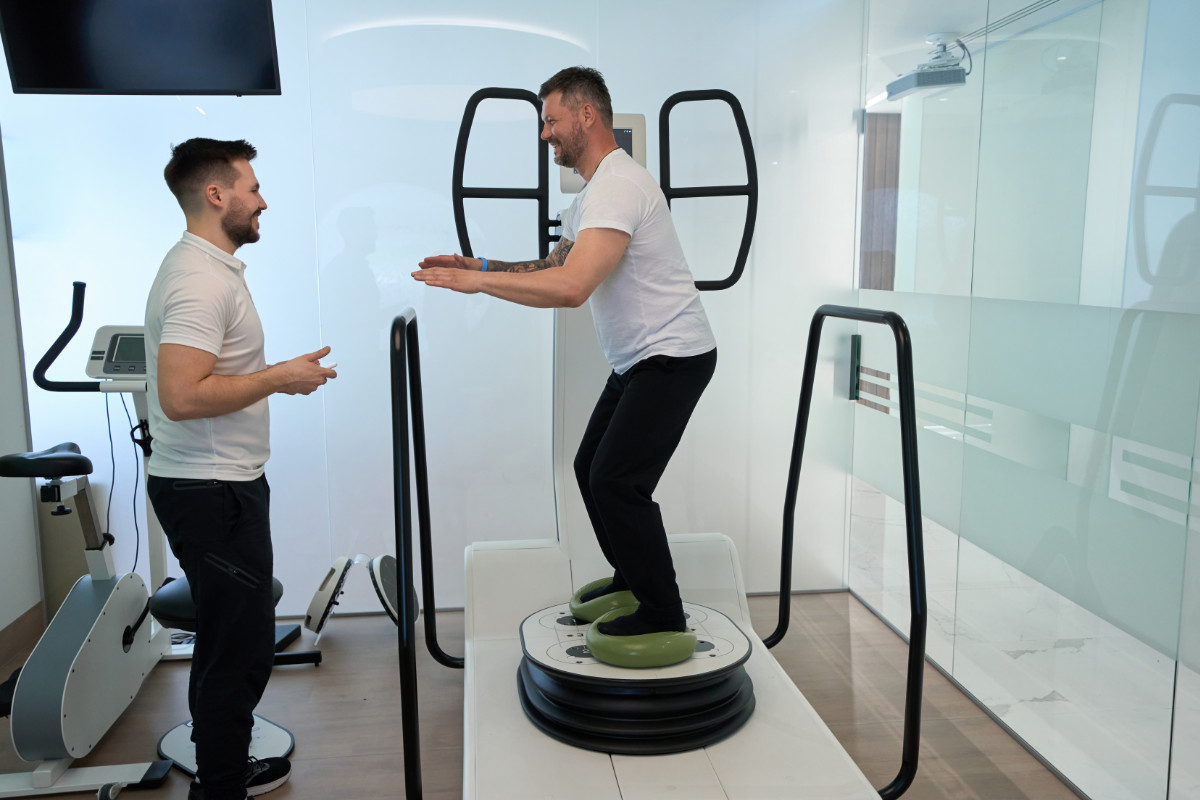Getting fit doesn’t need to be complicated. The 5 4 3 2 1 workout method is a straightforward training system that helps you build muscle and lose fat without spending hours in the gym. This method works by combining different rep ranges in one workout to target your muscles in multiple ways.
How Does The 5 4 3 2 1 Workout Method Actually Work?
The 5 4 3 2 1 workout method uses descending rep ranges with increasing weight. You start with 5 reps at a moderate weight, then do 4 reps at a heavier weight, followed by 3 reps at an even heavier weight, 2 reps near your maximum, and finally 1 rep at your heaviest weight.
This approach trains your muscles through different intensity zones in a single session. Research shows that varying rep ranges builds more muscle than sticking to just one range. When you lift heavy weights for low reps, you build strength. When you use moderate weights for higher reps, you build muscle size and endurance.
The method works because it challenges your body in multiple ways. Your first set of 5 reps warms up your muscles and nervous system. The middle sets of 4 and 3 reps build muscle mass. The final sets of 2 and 1 reps develop maximum strength. This combination creates a complete training stimulus.
What Exercises Work Best With This Method?
The 5 4 3 2 1 method works best with compound exercises that use multiple muscle groups. These exercises let you safely handle heavy weights and build the most muscle.
Top exercises for this method:
- Squats (builds legs and core)
- Deadlifts (works entire back and legs)
- Bench press (develops chest and arms)
- Overhead press (strengthens shoulders)
- Barbell rows (builds back muscles)
Avoid using this method for small muscle exercises like bicep curls or calf raises. These movements don’t suit heavy, low-rep training and increase injury risk. Stick to big movements where you can control the weight properly through the full range of motion.
How Much Weight Should You Use For Each Set?
Start with a weight you can lift for 8 reps comfortably. This becomes your starting point for the 5-rep set. Add 2.5kg to 5kg for each descending set.
Example weight progression for bench press:
- Set 1: 60kg for 5 reps
- Set 2: 65kg for 4 reps
- Set 3: 70kg for 3 reps
- Set 4: 75kg for 2 reps
- Set 5: 80kg for 1 rep
Your final single rep should feel challenging but not impossible. If you can’t complete the rep with good form, the weight is too heavy. Drop it by 2.5kg and try again next session.
Most people need 2 to 3 minutes rest between sets. This gives your muscles enough recovery to lift heavy weights safely. Don’t rush through the workout. Quality matters more than speed.
9 Steps To Shed 5–10kg in 6 Weeks
While spending as little as 90 minutes per week in the gym!
Includes an exercise plan, nutrition plan, and 20+ tips and tricks.
Without dead boring diets that are like watching paint dry
Without getting results at a snails pace
Gym or at home version
How Often Should You Train Using This Method?
Train each muscle group twice per week using the 5 4 3 2 1 method. This frequency builds muscle without overtraining. Your muscles need 48 to 72 hours to recover between heavy sessions.
A simple weekly schedule looks like this:
Monday: Chest and triceps
Tuesday: Legs and core
Wednesday: Rest
Thursday: Back and biceps
Friday: Shoulders and legs
Saturday: Rest
Sunday: Rest
This schedule gives you four training days with three rest days. The rest days are crucial. Your muscles grow during recovery, not during the workout itself. Studies show that training a muscle twice per week produces better results than training it once per week or every day.
What Results Can You Expect From This Training Method?
Most people see strength gains within 3 to 4 weeks of consistent training. Muscle growth takes longer, typically showing up after 6 to 8 weeks. The method works because it combines strength training with muscle building in one efficient workout.
Research on progressive overload shows that gradually increasing weight over time is the key to building muscle. The 5 4 3 2 1 method builds this progression into every workout. Each week, you try to add a small amount of weight to your lifts.
Your results depend on three factors: consistent training, proper nutrition, and adequate sleep. You can’t out-train a bad diet. Eat enough protein (around 1.6 grams per kilogram of body weight daily) and sleep 7 to 9 hours each night.
How Much Does It Cost To Start This Workout Method?
You can start this method at most gyms across Melbourne and Australia. A basic gym membership costs between $15 to $30 per week. Budget gyms like Jetts or Anytime Fitness charge around $15 to $20 weekly. Premium gyms with more equipment cost $25 to $40 per week.
If you prefer training at home, you need a barbell, weight plates, and a squat rack. A basic home setup costs:
- Olympic barbell: $200 to $400
- Weight plates (100kg set): $300 to $500
- Squat rack: $400 to $800
- Bench: $150 to $300
Total home gym cost: $1,050 to $2,000
The home gym option costs more upfront but saves money long term. After one year, a gym membership costs $780 to $1,560, while your home equipment lasts for years.
Who Should Use The 5 4 3 2 1 Workout Method?
This method suits people who have at least 3 to 6 months of training experience. Beginners should master basic movement patterns first before handling heavy weights. If you can squat, deadlift, and bench press with good form, you’re ready for this method.
The method works well for people who want to build both strength and muscle size. It’s efficient because you get multiple training benefits in one workout. Instead of doing separate strength days and muscle-building days, you combine them.
Avoid this method if you have joint problems or injuries. The heavy weights put stress on your joints and connective tissues. People over 50 should get clearance from their doctor before starting heavy strength training.
Common Mistakes People Make With This Method
The biggest mistake is adding weight too quickly. Your body needs time to adapt to heavy loads. Increase your weights by 2.5kg per week maximum. Jumping up 5kg or 10kg increases injury risk.
Another common error is skipping warm-up sets. Always do 2 to 3 light sets before starting your 5 4 3 2 1 sequence. Warm muscles perform better and stay injury-free.
Poor form is the third major mistake. Never sacrifice technique to lift heavier weight. A properly performed rep with lighter weight builds more muscle than a sloppy rep with heavy weight. Film yourself or work with a trainer to check your form.
Frequently Asked Questions
Can beginners use the 5 4 3 2 1 workout method?
No. Beginners need 3 to 6 months of basic training first. Learn proper form on compound exercises before attempting heavy, low-rep training. Start with 3 sets of 8 to 12 reps to build a foundation.
How long does each workout take?
Expect 45 to 60 minutes per session. This includes warm-up, the main workout, and cool-down. The rest periods between heavy sets add time but are necessary for performance and safety.
Can you lose fat using this method?
Yes. The method builds muscle, which increases your metabolism. Combined with a calorie deficit of 300 to 500 calories per day, you’ll lose fat while maintaining muscle. Eat enough protein to support muscle growth during fat loss.
Do you need a training partner?
A spotter helps with safety on heavy lifts like bench press and squats. If training alone, use a power rack with safety bars. These catch the weight if you fail a rep. Many Melbourne gyms have this equipment.
How do you know when to increase weight?
When you complete all 5 sets with good form, add 2.5kg to each set next session. If you can’t complete the final single rep, keep the same weights until you can. Progress takes time.
What should you eat before training?
Eat a meal with protein and carbs 2 to 3 hours before training. Good options include chicken with rice, eggs with toast, or Greek yogurt with fruit. This gives you energy for heavy lifting without feeling too full.
Is this method better than other training systems?
The method works well for building strength and muscle together. It’s not better or worse than other proven methods, just different. The best program is one you can stick to consistently. If you enjoy this structure and see results, keep using it.
The 5 4 3 2 1 workout method gives you a clear, simple structure for getting stronger and building muscle. It works because it combines proven training principles into one efficient system. Start with appropriate weights, focus on proper form, and increase the load gradually over time. With consistent effort and proper recovery, you’ll see measurable improvements in both strength and muscle size within 8 to 12 weeks.



